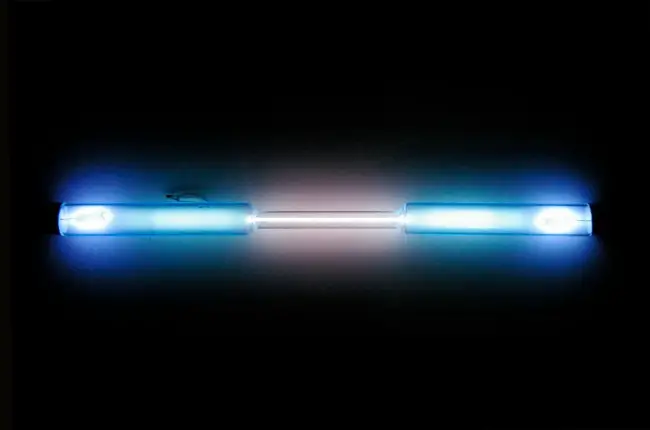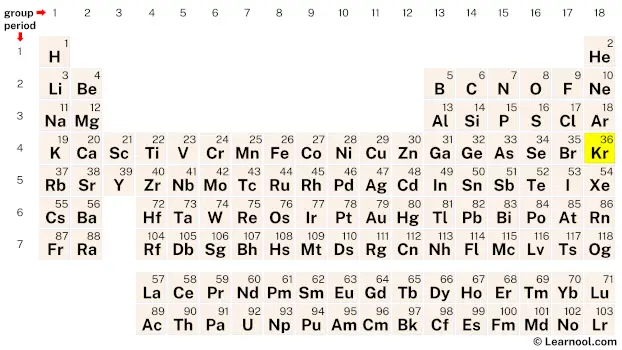
Krypton (Kr) is a chemical element of the periodic table, located in the group 18 and the period 4, and is having the atomic number 36. It is a colorless, odorless, tasteless gas, whose name comes from the Greek word “kryptos”, which means hidden. It is a member of the noble gas group.
On periodic table
| group | ⇨ | 1 | 2 | 3 | 4 | 5 | 6 | 7 | 8 | 9 | 10 | 11 | 12 | 13 | 14 | 15 | 16 | 17 | 18 |
| period | ⇩ | ||||||||||||||||||
| 1 | 1 H  Hydrogen |
2 He  Helium |
|||||||||||||||||
| 2 | 3 Li  Lithium |
4 Be  Beryllium |
5 B  Boron |
6 C  Carbon |
7 N  Nitrogen |
8 O  Oxygen |
9 F  Fluorine |
10 Ne  Neon |
|||||||||||
| 3 | 11 Na  Sodium |
12 Mg  Magnesium |
13 Al  Aluminium |
14 Si Silicon |
15 P  Phosphorus |
16 S  Sulfur |
17 Cl  Chlorine |
18 Ar  Argon |
|||||||||||
| 4 | 19 K  Potassium |
20 Ca  Calcium |
21 Sc  Scandium |
22 Ti  Titanium |
23 V  Vanadium |
24 Cr  Chromium |
25 Mn  Manganese |
26 Fe  Iron |
27 Co  Cobalt |
28 Ni  Nickel |
29 Cu  Copper |
30 Zn  Zinc |
31 Ga  Gallium |
32 Ge  Germanium |
33 As  Arsenic |
34 Se  Selenium |
35 Br  Bromine |
36 Kr Krypton |
|
| 5 | 37 Rb  Rubidium |
38 Sr  Strontium |
39 Y  Yttrium |
40 Zr  Zirconium |
41 Nb  Niobium |
42 Mo  Molybdenum |
43 Tc  Technetium |
44 Ru  Ruthenium |
45 Rh  Rhodium |
46 Pd  Palladium |
47 Ag  Silver |
48 Cd  Cadmium |
49 In  Indium |
50 Sn  Tin |
51 Sb  Antimony |
52 Te  Tellurium |
53 I  Iodine |
54 Xe  Xenon |
|
| 6 | 55 Cs  Caesium |
56 Ba  Barium |
72 Hf  Hafnium |
73 Ta  Tantalum |
74 W  Tungsten |
75 Re  Rhenium |
76 Os  Osmium |
77 Ir  Iridium |
78 Pt  Platinum |
79 Au  Gold |
80 Hg  Mercury |
81 Tl  Thallium |
82 Pb  Lead |
83 Bi  Bismuth |
84 Po  Polonium |
85 At  Astatine |
86 Rn  Radon |
||
| 7 | 87 Fr  Francium |
88 Ra  Radium |
104 Rf  Rutherfordium |
105 Db  Dubnium |
106 Sg  Seaborgium |
107 Bh  Bohrium |
108 Hs  Hassium |
109 Mt  Meitnerium |
110 Ds  Darmstadtium |
111 Rg  Roentgenium |
112 Cn  Copernicium |
113 Nh  Nihonium |
114 Fl  Flerovium |
115 Mc  Moscovium |
116 Lv  Livermorium |
117 Ts  Tennessine |
118 Og  Oganesson |
||
| 57 La  Lanthanum |
58 Ce  Cerium |
59 Pr  Praseodymium |
60 Nd  Neodymium |
61 Pm  Promethium |
62 Sm  Samarium |
63 Eu  Europium |
64 Gd  Gadolinium |
65 Tb  Terbium |
66 Dy  Dysprosium |
67 Ho  Holmium |
68 Er  Erbium |
69 Tm  Thulium |
70 Yb  Ytterbium |
71 Lu  Lutetium |
|||||
| 89 Ac  Actinium |
90 Th  Thorium |
91 Pa  Protactinium |
92 U  Uranium |
93 Np  Neptunium |
94 Pu  Plutonium |
95 Am  Americium |
96 Cm  Curium |
97 Bk  Berkelium |
98 Cf  Californium |
99 Es  Einsteinium |
100 Fm  Fermium |
101 Md  Mendelevium |
102 No  Nobelium |
103 Lr  Lawrencium |
|||||
| – p block |
Krypton is a p-block element, situated in the eighteenth column, also known as the noble gas group of the periodic table, next to bromine (Br). It has the atomic number 36 and is denoted by the symbol Kr.
Element information
 |
|
 |
|
| Origin of name | Greek word “kryptos” (which means hidden) |
| Symbol | Kr |
| Atomic number (Z) | 26 |
| Atomic mass | 83.798 u |
| Block | p-block |
| Group | 18 |
| Period | 4 |
| Classification | Noble gas |
| Covalent radius | 116±4 pm |
| Van der Waals radius | 202 pm |
| Melting point | -157.37 ℃, -251.27 ℉, 115.78 K |
| Boiling point | -153.415 ℃, -244.147 ℉, 119.93 K |
| Electron configuration | [Ar] 3d10 4s2 4p6 |
| Electrons per shell | 2, 8, 18, 8 |
| Learn how to draw: Krypton Bohr model | |
| Crystal structure | Face-centered cubic (fcc) |
| Phase at r.t | Gas |
| Density near r.t | 3.749 g/L |
| Main isotopes | Krypton-80, Krypton-82, Krypton-83, Krypton-84, Krypton-86 |
| Natural occurrence | Primordial |
| Oxidation state | 0 |
| Electronegativity (Pauling scale) | 3.00 |
| Protons Neutrons Electrons |
36 48 36 |
| Learn how to find: Krypton protons neutrons electrons | |
| Valence electrons | 8 |
| Learn how to find: Krypton valence electrons | |
| CAS number | 7439-90-9 |
| Discovered by | William Ramsay and Morris Travers in 1898 |
History
Krypton was first discovered in 1898 by the British chemists William Ramsay and Morris Travers in the residue left after evaporating nearly all components of liquid air. Krypton was the first element to be discovered using this technique, which later led to the discovery of other noble gases such as neon, xenon, and argon. The name Krypton is derived from the Greek word “kryptos,” which means “hidden” or “concealed,” as it is difficult to extract from air.
Following its discovery, krypton remained largely a scientific curiosity until the 1930s, when it began to be used in light bulbs and photography. It wasn’t until the 1960s that krypton gained more widespread use, particularly in the fields of nuclear energy and lighting. Today, krypton is primarily used in lighting, such as fluorescent lamps, as well as in gas lasers, high-speed photography, and as a filling gas in some types of insulation.
Occurrence and production
Krypton is a rare gas that is found in trace amounts in the Earth’s atmosphere, at a concentration of about 1 ppm (parts per million) by volume. It is produced by the radioactive decay of uranium and thorium in the Earth’s crust. Krypton is also found in some minerals, such as feldspar and mica, although in very small amounts.
Krypton can be produced through several methods, including fractional distillation of liquefied air, which separates krypton from other gases in the air such as oxygen, nitrogen, and argon. Another method involves the use of cryogenic distillation, where the air is first cooled to very low temperatures to liquify it, and then the krypton is separated from the other gases.
Krypton can also be produced through the process of nuclear fission, where uranium or plutonium is used as a fuel in a nuclear reactor to produce energy, and krypton is one of the by-products of the nuclear reaction. This method is mainly used for scientific research purposes and for the production of medical isotopes.
Properties
Physical properties
Krypton is a colorless, odorless, and tasteless gas.
It is a noble gas and is monatomic, meaning it exists as single atoms rather than molecules.
It has a boiling point of -153.415 ℃ and a melting point of -157.37 ℃.
Krypton has a very low solubility in water and other liquids.
Chemical properties
As a noble gas, krypton is generally chemically inert and does not react with other elements under normal conditions.
However, krypton can form compounds under certain extreme conditions, such as with fluorine, oxygen, and nitrogen.
Krypton has six stable isotopes, with mass numbers of 78, 80, 82, 83, 84, and 86, and the most abundant of these is krypton-84, which makes up about 57% of naturally occurring krypton.
Toxicity
Krypton is generally non-toxic since it is chemically inert and does not react with the body.
However, in high concentrations, it can displace oxygen and cause asphyxiation.
Other properties
Krypton is used in certain types of lighting, including fluorescent lamps and photographic flashes.
It is also used in certain types of lasers and as a filling gas in gas-filled radiation detectors.
Applications
Lighting
Krypton is used in certain types of lighting, particularly in high-intensity discharge lamps. These lamps are used in streetlights, stadium lights, and other applications where bright, efficient lighting is needed.
Windows
Krypton can be used to fill the space between double-paned windows. This helps to reduce heat transfer and improve the energy efficiency of the windows.
Laser technology
Krypton gas is used in some types of lasers, particularly in high-powered gas lasers used in industrial cutting and welding applications.
Medical imaging
Krypton can be used in medical imaging, particularly in magnetic resonance imaging (MRI) applications. Krypton is used as a contrast agent to help highlight certain tissues in the body.
Research
Krypton has a number of research applications, particularly in the field of nuclear physics. It can be used as a target for nuclear reactions and for studying the properties of nuclear particles.
Interesting facts
Krypton is a noble gas that glows in bright colors when electricity is passed through it. This is why it is often used in lighting, such as in fluorescent lamps and photographic flashes.
Krypton was discovered in 1898 by British chemist Sir William Ramsay and his student Morris Travers. They were studying the residue left behind after evaporating liquid air when they discovered krypton.
Krypton is one of the rarest elements on Earth, making up only about 1 part per million of the atmosphere.
Krypton has several isotopes, but only one of them, krypton-85, is radioactive. This isotope is produced by nuclear fission and can be used to detect leaks in sealed systems.
Krypton is used in the production of some types of lasers, such as those used in barcode scanners and some medical equipment.
Krypton was named after the Greek word “kryptos,” which means hidden, because it was difficult to detect and isolate.
Krypton has a high potential for use in nuclear fusion research, as it is an inert gas and can be used to create a stable plasma.
Related
More elements
External links
- https://www.rsc.org/periodic-table/element/36/krypton
- https://en.wikipedia.org/wiki/Krypton
- https://www.britannica.com/science/krypton-chemical-element
- https://www.chemicool.com/elements/krypton.html
- https://www.acs.org/content/acs/en/molecule-of-the-week/archive/k/krypton.html
- https://pubchem.ncbi.nlm.nih.gov/element/Krypton
- https://education.jlab.org/itselemental/ele036.html
- https://www.livescience.com/32076-krypton.html
Deep
Learnool.com was founded by Deep Rana, who is a mechanical engineer by profession and a blogger by passion. He has a good conceptual knowledge on different educational topics and he provides the same on this website. He loves to learn something new everyday and believes that the best utilization of free time is developing a new skill.
